Football in America: Bridging Communities in the Bay Area

Today, The MMQB, in partnership with State Farm, begins an eight-week series called Football in America. We’ll take the temperature of the game at the youth, high school, college and NFL levels in a changing world, in eight places across the United States: from San Francisco to Philadelphia, from Minneapolis to Phoenix.
Our first stop: the Bay Area, with visits to a high school in San Francisco as coaches fight to save potentially wayward kids through the structure and discipline of football; to Marshawn Lynch’s old youth program in Oakland; to Berkeley to get the feel for the trappings of a big-time college football game in the Bay Area; and to the Black Hole for the Raiders’ season opener, their first game as lame ducks in Oakland. Part of the program will be to identify an object that stands as a “most valuable possession” regarding football in that locale, and for the Bay Area we could think of nothing so much as the bridges that connect communities and teams and fans throughout the region. You’ll see that especially in the video accompanying this piece.
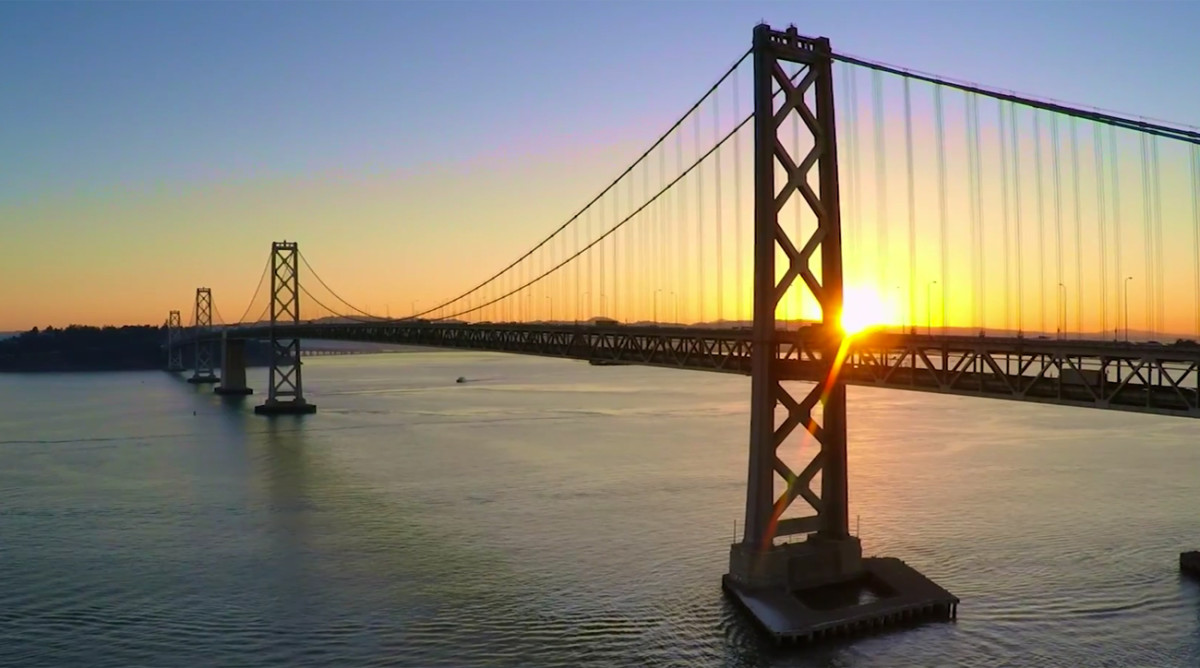
Please give us your feedback, and your ideas for future episodes in this series, at talkback@themmqb.com.
Video: Tiff Oshinsky
Photos, Social: Kalyn Kahler
At Mission High, a Way Out
Kezar Stadium, San Francisco
Friday, 7 p.m. PT
On the running track encircling storied Kezar Stadium, a few minutes before the start of inner-city Mission High’s game against visiting non-conference San Mateo, senior safety/running back Jamal Dixon, dressed in his brown Mission Bears uniform, approaches his mother for their weekly ritual. From the stands, the scent of marijuana wafts down from the tiny crowd. But mother and son don’t notice. They’re locked onto each other. Melanie Williams closes her eyes. She lays her hands on his arms, and then his torso, all the way down to his legs. “God give you the protection from your head to your toe,” she says. “No weapon formed against you shall prosper! In Jesus’s name, I say amen.”
“Amen,” Jamal says.
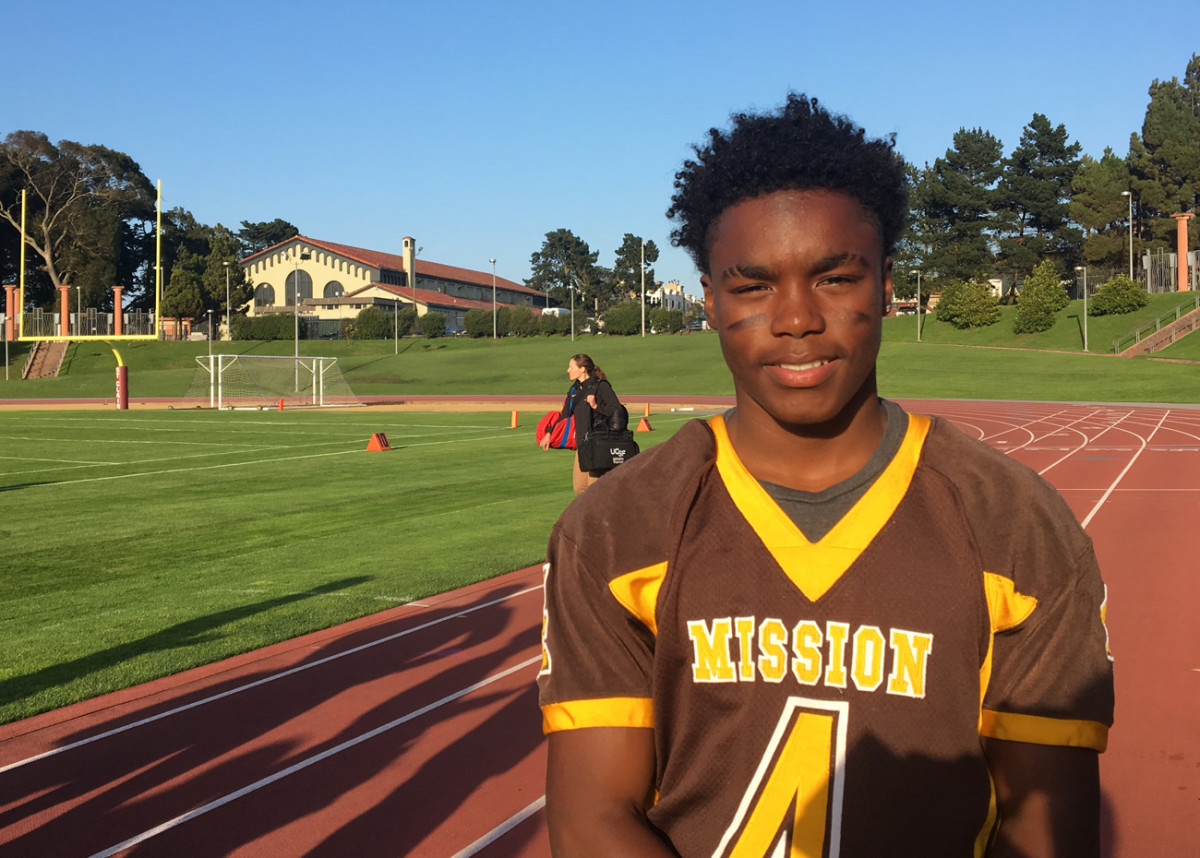
They hug, and and Melanie watches as he goes to the sideline to join his 31 teammates. Her son entered Mission High as a freshman wearing an ankle-monitoring device for a short time for some juvenile trouble he’d been in, and now his mom watched with the pride of knowing he’d been accepted to four colleges just this week, with a future so much more promising than it was seven years earlier.
Seven years ago this week, Melanie Williams says, “His daddy got murdered in a home invasion—and Jamal seen it. The last thing that his Daddy said to him was, ‘Stay with football, not the streets.’ And he’s been playing ever since.”
Before the game, Jamal prays to his father. This game has some special significance, because the sight he saw, the murder of his father, never leaves him. “September the 14th, yesterday, was the day he got killed seven years ago,” Jamal, a serious kid, says. “So today I gotta ball out for him.”
There are 32 stories on the Mission High football team. Some of these kids will make it, and escape desperate circumstances. Some won’t. Some, co-coach Lamar Williams says, “will get caught in the tornado. You lose kids for sure. But Jamal has hope. He has football.” That’s the thing about the game to the families and the players at Mission High. For all the cautionary tales about the future of football, for all the legitimate concern about head trauma, for all the worries about what the physicality of the sport will do to players later in life, the Melanie Williamses and Jamal Dixons aren’t thinking about that. For them, football is a potential way out, one of the only paths they see for a decent future outside the bleak environment of their current lives.
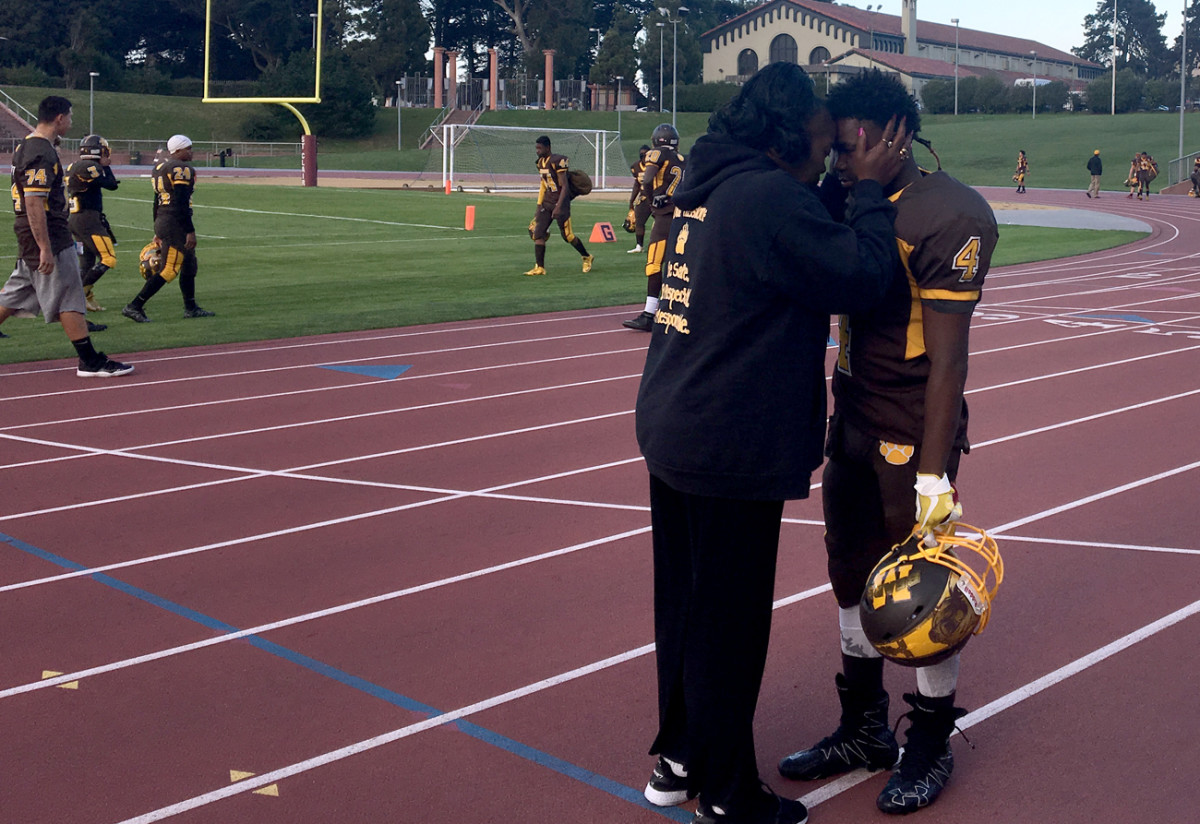
They don’t try to justify what they think about football. They understand the dangers. But walk in their shoes. The way Melanie Williams sees it, it’s a black-and-white choice for her son: Use football to help make a better life, or risk what she’s she’s seen happen so many times already. “Two of his best friends, kids I paid for them to go to football camp a couple of years ago,” she said. “I hustled the money from my church. But they stopped going. They told Jamal, ‘Don’t go.’ He went. Now one’s on drugs. One’s in juvenile.”
And it’s not just the prospect of playing the game in college, or, as some this weekend will bring up, for the Powerball-type chance to follow in Bay Area native Marshawn Lynch’s footsteps to the millionaire’s life in the NFL. Mostly, it’s the daily work with men like co-coaches Williams and Greg Hill, men who will call Jamal and his mates some days and say, “Hey, get your ass up! Time to go to school!” Football and the coaches and the teammates provide regularity, focus, and structure, and a reason to not give up.
“I got five to eight guys on the team with a story like Jamal’s,” says Hill. “That’s a part of the San Francisco life. When he came to this school, his dad had died, and he was like, I don’t care, F the world. But he’s stuck with it. He’s still got some growing to do, but football’s really helped Jamal.”
The game starts. San Mateo is sharper, with more players, more coaches. Hill has benched his starting quarterback for a discipline issue. But in the first half, the San Mateo quarterback, driving for a touchdown, throws a deep ball down the left sideline to a big receiver, and here comes Jamal Dixon. At the goal line, he leaps and picks off the pas, coming down with the ball to the shrieks of his mother in the first row of the Kezar seats. He sprints and feints and returns it 35 yards, leading to a Mission touchdown.
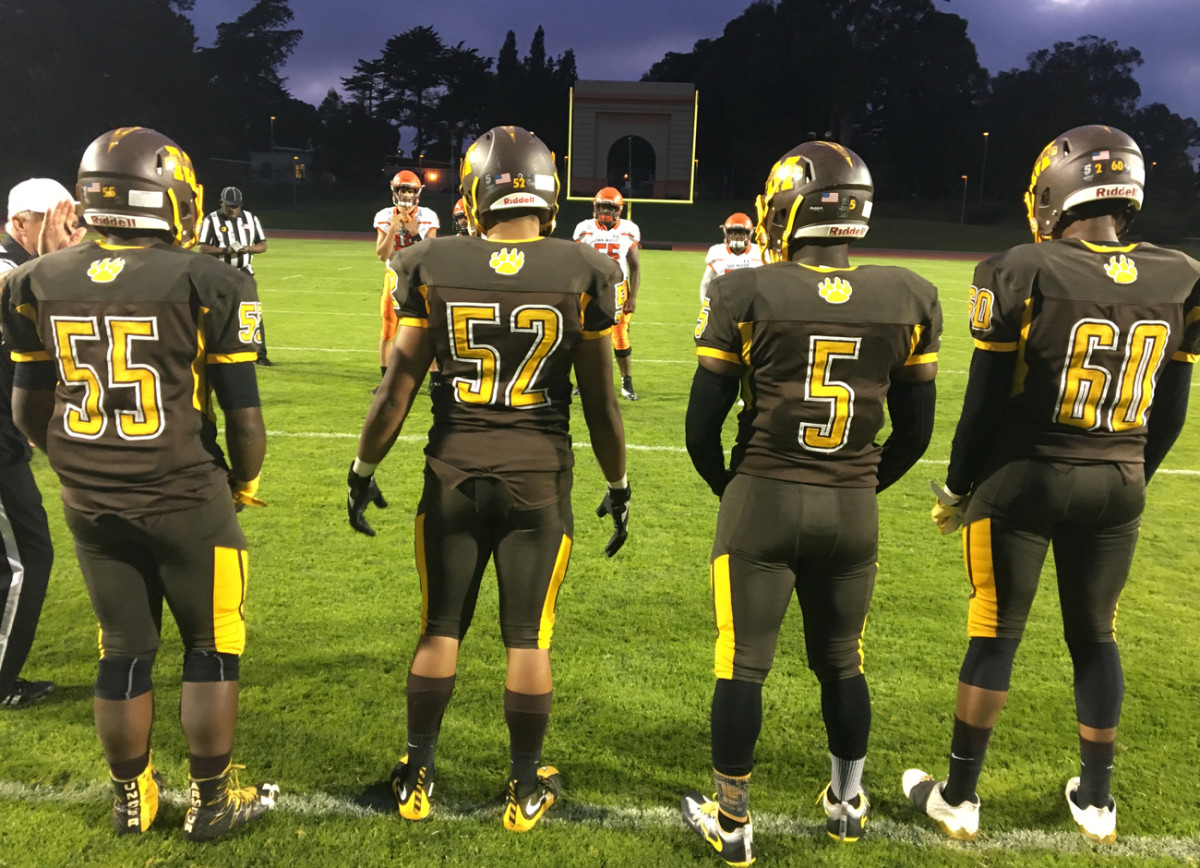
And then high school kids do what high schools kids do when a touchdown happens. They go crazy, slapping each other and jumping on each other and engulfing the TD kid, LeCharles Wells when he comes to the sidelines. “THAT’S MY FIRST TOUCHDOWN!” Wells says.
The final: San Mateo 16, Mission 6. Not a surprise.
“I like to schedule tough non-conference games,” Hill says afterward. “Makes us better. But we have to keep in perspective the important things. Jamal got accepted to four colleges this week. We’ll be okay.”
Memories of Marshawn in an Oakland Youth League
Jackie Jensen Field, Oakland High School
Saturday, 10 a.m.
“IT DON’T FEEL TOO GOOD, DO IT??!!!” yells one of the coaches of the Oakland Dynamites eight-and-under team, the Mighty Mites, after their Saturday foe scores to go up 14-0 on the artificial turf football field behind Oakland High.
Lots of action here, on a day when five of the six Oakland Dynamite teams have games between 8 a.m. and mid-afternoon in the NorCal American Youth Football League. Teams field between 16 and 20 players on squads ranging from seven-and-under to 12-and-under. Bleachers dotted with groups of parents. Yellow-uniformed Dynamite cheerleaders with OD CHEER uniforms on the sideline. Steaks being grilled and candy sold in one end zone. A booster club table, looking for coaches and other volunteers. Coaches apparently doing their job not to every parent’s satisfaction. One parent walks up to a Dynamite coach on the sideline and loudly tells him he doesn’t know what he’s doing. Four or five parents and coaches get in the middle of them, and a woman from the crowd chimes in, “Act like a [expletive] coach!” The cheerleaders scream and drop their pompoms. After a few minutes, the game resumes, peacefully but unsuccessfully for the Dynamites.
This is the program that gave Marshawn Lynch his start. Saturdays are big community days here in the fall, with kids, like Lynch 23 years ago, using football for some structure and exercise in hardscrabble Oakland.
“I know Marshawn,” says the quarterback of the 10-and-under Junior Peewee team, Rafael Campbell Jr. He’s very polite. “My favorite team is the Seahawks, from him. He’s basically like my family.”
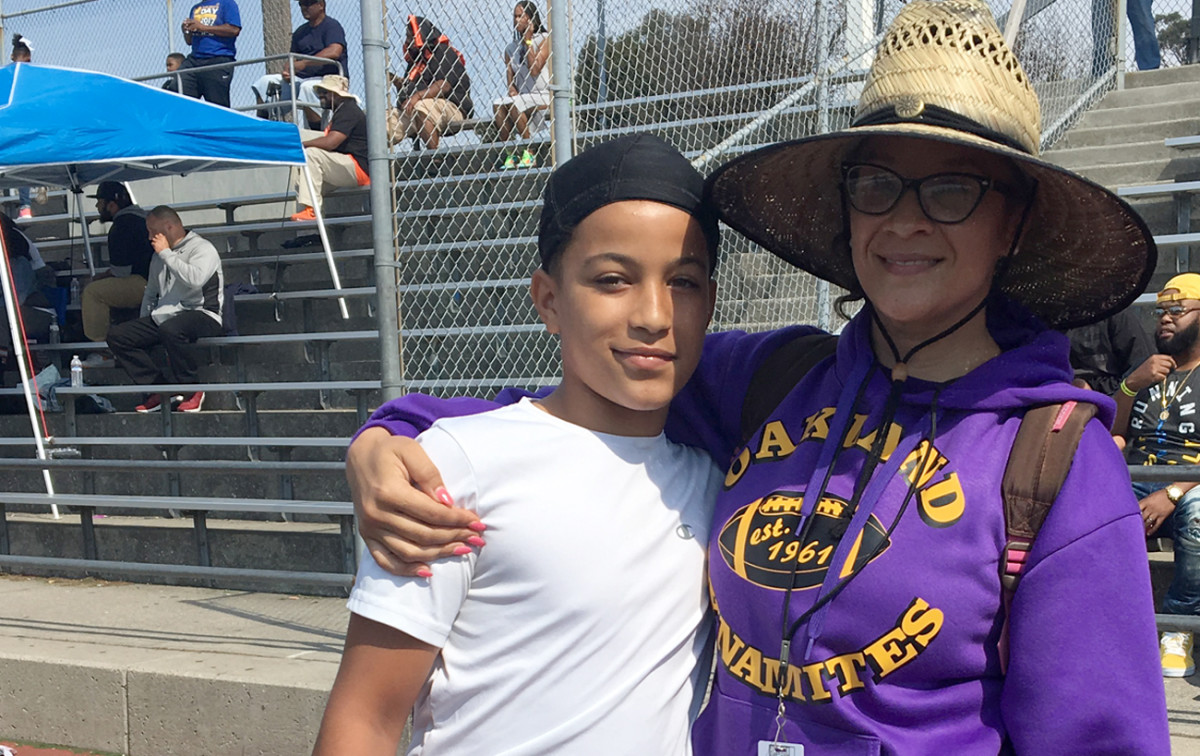
“Has he given you any advice?” I ask Rafael.
“Go to school. Stay in school. Stay off the streets.”
Rafael’s mother, Tanisha Kemanis, is the team mom for the program. She spends this Saturday in organizational mode under a sun cover on the sidelines, keeping the games going and serving as conduit of information about the program for parents with questions. Kemanis is an accountant. She tells Rafael he must maintain a B average in school or there will be no football. And he keeps that B average.
“We preach grades in this program,” she says. “And we get them early, so they have something positive, and this becomes home for them. Marshawn has been great to these kids and to this program, and he’s our hometown hero, for sure. But he’s one-in-a-million; we don’t preach ‘You can be like Marshawn,’ because obviously the odds are so long. Really, we just want the kids in a positive activity. I don’t care it they play chess. Do something.”
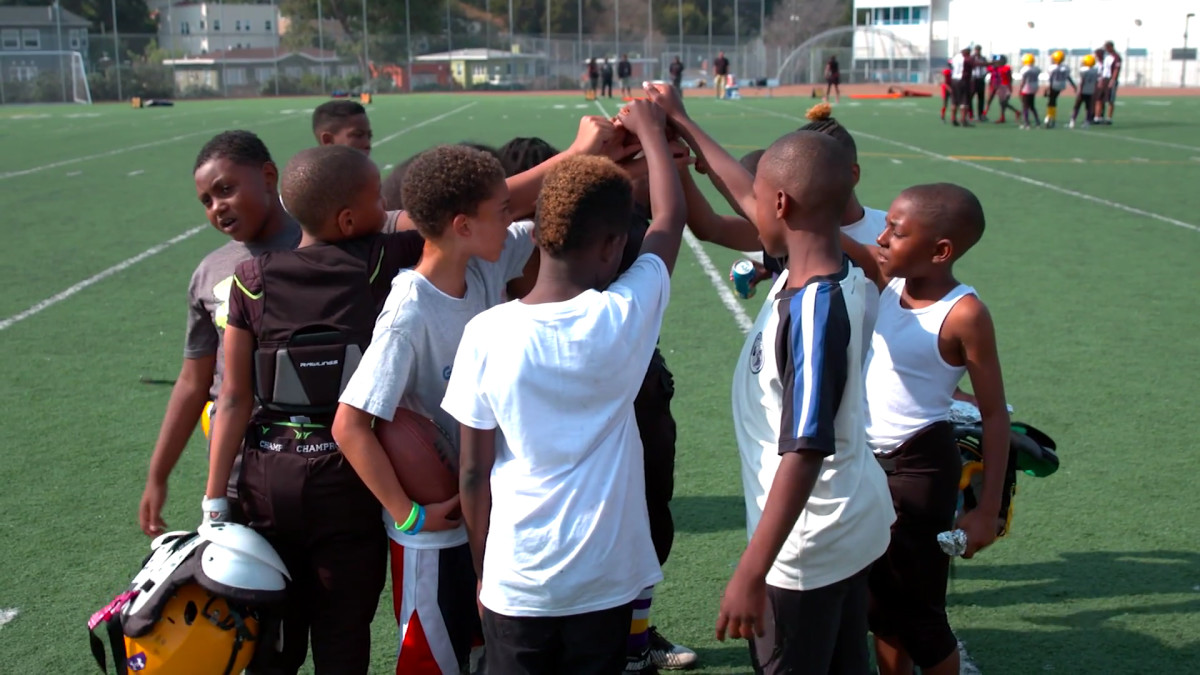
Fears surrounding tackle football at a young age have thinned the herd, though. Flag football is growing—to the point that the flag program in the area gets priority on some of the field that one was for tackle football only. Some kids in the Dynamite program play both, or have quit tackle to play flag. “It’s been a concern for the parents,” Kemanis says. “This is tackle football. It’s a rough game. Our coaches are trained better, though. They take a proper tackling technique test. They know how to do the concussion test on kids.”
“At the end of the day, this is an important part of the kids’ lives. It’s about getting kids off the streets in Oakland.”
Old Friends and New, and the View from Above
Cal campus, Berkeley
Saturday, 5:30 p.m.
The football weekend began with two cityscapes of football as life raft. Now, a couple of hours before Mississippi-Cal, on a walk to a 200-person tailgate in the center of campus, I witness three college football scenes:
• Two male drummers, in full Cal band uniforms with spatted shoes, are stopped by an Ole Miss fan, 65ish, dressed in a bright red polo with Ole Miss logo over the heart. The Rebel fan says: “Y’all know Dixie?” One of the kids says, “No. We’re from California.”
• On the way to the stadium, eight cheerleaders dressed in their blue-and-gold garb, with blue-and-gold pompoms, get stopped by a Cal fan, maybe 40. “Honey,” he says to his wife (presumably), “would you take our picture?” Four cheerleaders form on his left, four on his right. “Go Bears!” a couple of them say as the photo is snapped. “We’ve got our Christmas card photo, honey,” the guy says.
• At the Tap Haus, a German-style beer hall, a table of four pregamers identify themselves as recent Cal alums. The game is at 7:30; they look pretty well hammered. I ask how long they’ve been here. “Since 1,” one says. “It’s our tradition when we play Saturday nights—come here for a few hours, watch all the games from around the country, then go to our game.”
The 2328 Legacy Tailgate is a sight to behold. Run by Cal grad and local attorney Eddy Kleinhans (2328 was the off-campus street number of the house Kleinhans and seven Cal student pals lived in 25 years ago), it’s in a space spotted with ancient huge oak trees, about 20 yards by 20 yards, with people of all ages, but primarily 40-somethings. Fifteen or so Ole Miss fans are here. A TV on a tabletop is set up at one end; USC-Texas for those who can’t get enough football. Two chefs-for-the-afternoon have prepared an amazing spread, Mexican food with a some barbecue for the southern visitors. On the menu is a Hugh Freeze Special. You may recall the Ole Miss coach who was fired for allegedly using a university-issued phone to call escort services. “The Hugh Freeze Special: With one single call, we’ll put your sausage in a fresh warm taco. Cream on the side.” Yowza. Best line, but not the best food here. The Mexican street corn, with crema, mayonnaise and lime sauce, and Tapatio hot sauce, is just outrageous.
• THE MMQB ON INSTAGRAM: Follow for more Football in America
Adam Duritz of Counting Crows has been to past 2328 Legacy tailgates, and Olympic gold medal swimmer Natalie Coughlin, and New Jersey Nets GM Sean Marks, and my buddy Mike Silver (my connection to the food and drink and here).
“We say we may not always win the game, but we will win the party,” Kleinhans says. “So this is our 25th year. We’ve seen our kids born, and grow, and some even go here to Cal. All the people here, it’s six degrees of separation. And it’s an open tailgate. All welcome—except when we play Stanford. For the Stanford games, no Stanford people allowed. No exceptions, not even spouses of Cal grads.”
“How much does this add to your enjoyment of football?” I ask. “What would football be like without this?”
“Boring,” Klinhans says. “The tailgating experience, for us, is almost more important than the game now. People are working all over the place now—some of them traveling in just for this game. We don’t see our friends as much as we used to, and most of us sit all over the stadium instead of all together. So this part of it is so important. We connect here with one common goal—rooting for our Bears.”
From there I walk to see the cannon the school has used for 53 years, firing when the team comes out before the game and after touchdowns. “Walk” is a relative term. “Climb” is more like it. On my FitBit, the trek to the spot high above the stadium on Tightwad Hill registered 57 flights of stairs. The cannon is on a platform, and through a gap in the tall trees in front of me, the two teams look like ants down below. To my right is one of the great views in the United States—the western horizon, sun setting, the Pacific Ocean in the distance.
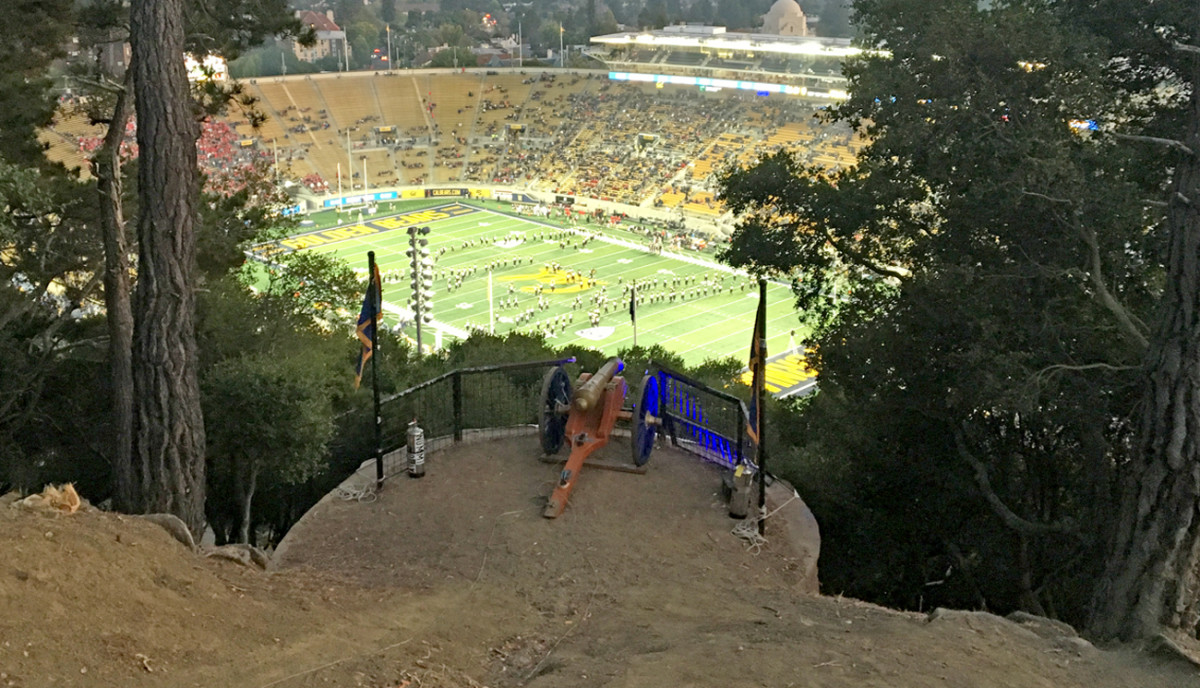
Such a peaceful place. Such a pacifist university. Strange to have a tradition like a cannon at Cal. But that’s college football. Weird customs abound. “We have a lot of traditions at the university,” says one of the students known as the cannoneers, Luke Birdsong of Hydes, Md. “We were the first school to start card stunts, back in 1910. We have a great student section that gets to sit at the 50-yard-line. At a lot of other universities they don’t give that spot to their students. So we have a lot of traditions on campus, some that aren’t even athletic. The cannon is just one of those great things we have.”
Cal 27, Mississippi 16, on a big second-half comeback. But when you come to Berkeley on game day, the football can take a backseat to the traditions. For so many here, the game is secondary. Or tertiary.
Three stops in. So far, football’s been a savior, a worry and a party—and all seem significant. What would an NFL Sunday at one of the most fascinating places on earth bring?
Bright Days in the Black Hole
Oakland-Alameda County Stadium
Sunday, 11:15 a.m.
I command you:
Go to a Raiders home game before the end of 2018. Get there three hours before game time. Park your car on the west side of I-880 in one of the pay lots. Walk back over the highway onto the property of the stadium. Then walk through the parking lots on the north side of the stadium. Give yourself two hours to meet the people and see 500 tailgates. At least.
This, as recorded by The MMQB’s Kalyn Kahler Sunday morning when we walked the lots, is what you’ll see and hear:
Cigars. Filets. Andouille sausage. Burgers. Cheap dogs. Raider-themed Bud Light cans. Dancing people. Tito’s Handmade Vodka. Rap. Sinatra. Gangsta Rap. Freakazoids. An 89-year-old woman with a Raiders jacket, a Raiders watch, Raider rings. Grills handmade for Raider nutjobs. A ton of STABLER 12 jerseys. More LYNCH 24 jerseys. Some creative shirts from players you might not have hear of, like F’S GIVEN 0. Chips. Salsa. Guac. Skittles. Boomboxes. Crappy old radios. Gigantic boomboxes. More Modelos than you’d see in 16 Mexico City liquor stores.
Blacks. Whites. Hispanics. Asians.
More African-Americans than I’ve seen at any other NFL game—maybe ever.
Insurance salesmen. Dudes in Raider Halloween costumes. Moms cooking sausages. Kids playing cornhole.
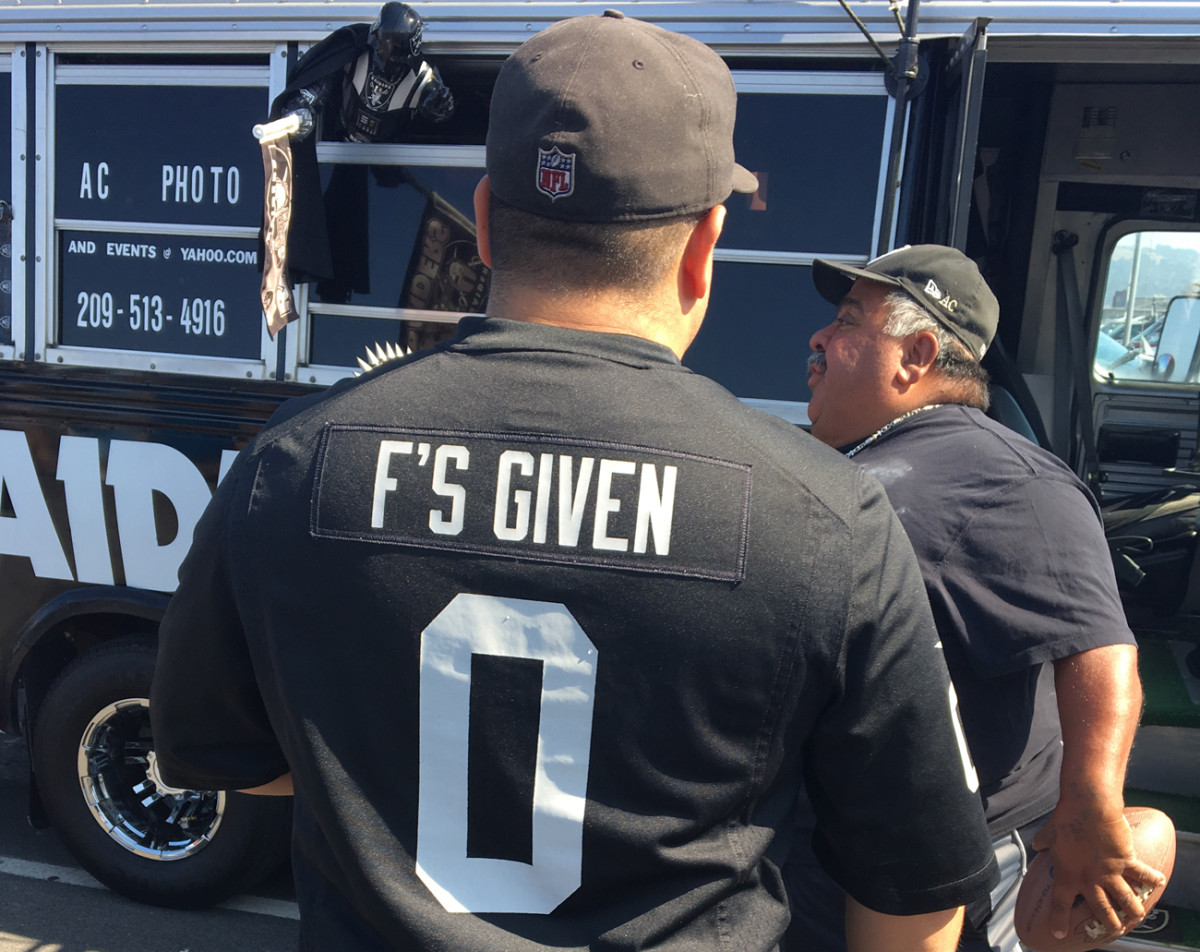
The melting pot that is the United States. It’s right here, in a parking lot in northern California.
Go to see the Raiders, because atmospheres like this one—scary to some, real to others—are disappearing around the corporate NFL. Cleveland is still something like this. Buffalo is a lot like this. Pittsburgh and Green Bay (though more civil) and Kansas City and Chicago and Denver are. San Diego approached it. Just go. You’ll love it. And you’ll get some free food, and seven beers.
Unlike lots of parking lots around the NFL, these tailgates are packed together. It’s like the biggest flea market you’ve ever seen with no space between the vendors. The thought that the Raiders, when they move to Vegas in 2019 or 2020, won’t be able to tailgate at the stadium and will have to park three miles from the stadium, a possibility that surfaced in July … that’s just a stunner. And a bummer. The pregame is how these fans survived for a decade when this team was awful.
I meet 44-year-old Gabriel Nevarez of Newark, Calif., who like so many here was disgusted by the Raiders’ move and at the same time still madly in love with the team he’d loved since he was kid. It’s killing him that he hung in with the team through the bad times, and now that Derek Carr and Khalil Mack seem close to bringing the Raiders back to the days of Stabler and Alzado, the franchise is moving. Again.
“I just don’t think anyone understands how in the heck you go from here, from Silicon Valley, a place where this land in this parking lot is probably worth all of Vegas, you know, and you look to go to a mudhole in Vegas,” Nevarez says. “Who wants to be there on a Sunday afternoon? Usually you’re broke, or you’re in jail, or trying to get the hell out of there. And where else can you go and tailgate like this? It’s very few and far between these days, with all these new stadiums. This is something you can only do here. They are getting away from all this. It just sucks to see it go, because this is how you want to bring your kids up—loving a team. When I was younger people always said about this place, ‘Oh, don’t go there, don’t go there. It’s rowdy.’ I was bringing my kid when he was two years old. We’ve never had any issues. This place is great.”
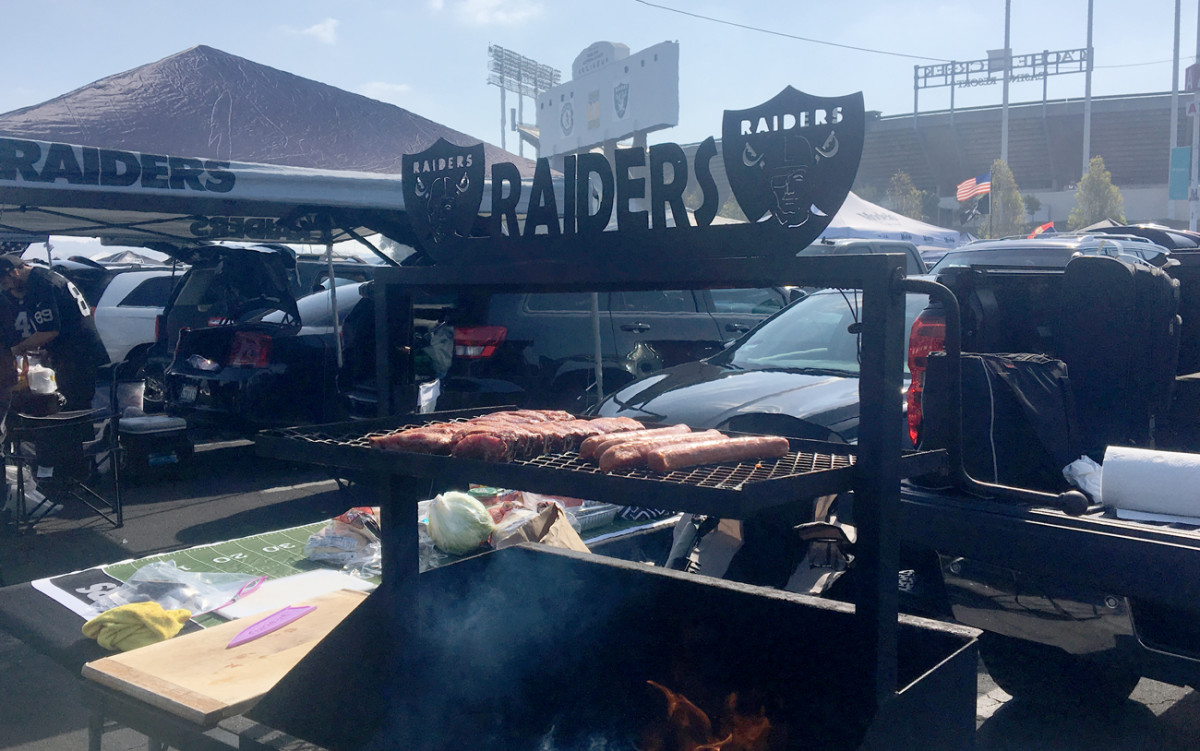
A few spirals away, Thelma Maggio, 89, of Concord, Calif., sat in a Raiders tent while the rest of her extended family partied. She showed off her Raiders watch, which she bought the day she heard the team was moving to Vegas, because she wanted something to remember the team by.
“I don’t know who to blame,” she says to The MMQB’sKalyn Kahler. “I wish I knew who to blame.”
Judging by this reaction, who knows what’s to come when the Raiders kick off the season against the Jets on a brilliant and warm and windless afternoon, a perfect day for football. “It’ll be a raucous crowd, and I really don’t know what to expect,” says Tim Cronen, 54, of Phoenix, who comes to at least one game every year. “There’s gonna be a lot of fan support, to show the politicians and the city of Oakland that you made a mistake. You made a mistake by letting this team go.”
Turns out it’s a love fest. The Raiders put up 45 points, new Raider and hometown boy Marshawn Lynch scores a touchdown on his home turf, and there isn’t a single chance for the crown of 54,000 to be remotely pissed off. Lynch drives the crowd nuts when he spends a full 45 seconds dancing to the explicit rap tune “Oakland,” featuring D.J. Mustard, in the second half.
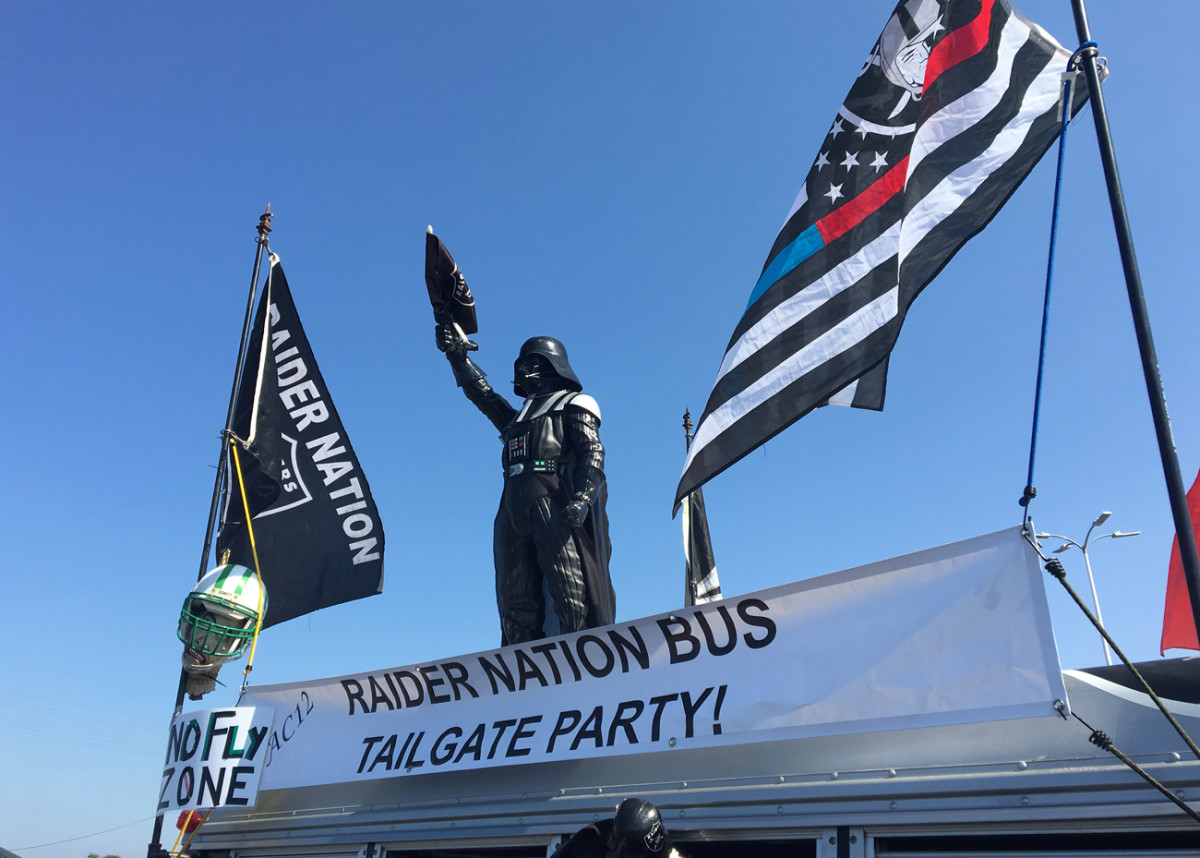
A fascinating day: The stadium is a pit. It’s cramped. The concourses force you to walk narrowly and slowly and say, “Excuse me,” about 16 times a minute. But there’s so much to like about the 2017 Raiders that you leave the place and you looks around at the fans and think, That was fun.
“I didn’t sense the fans were thinking about Vegas,” tackle Donald Penn says afterward. “Did you?”
Football is a lot like the United States. Deeply flawed, enervating, fun to watch (did you see some of Derek Carr’s throws Sunday, particularly the back-shoulder jobs when no one in the place but him and his receiver knew they were coming?), rewarding, and a port in the storm for so many young people in America. That’s what this four-stop weekend showed. As we go further in the series, we’ll see how other places in the country compare, and take the temperature of football as it heads to an uncertain future.
Question or comment on this series? Email us at talkback@themmqb.com.
